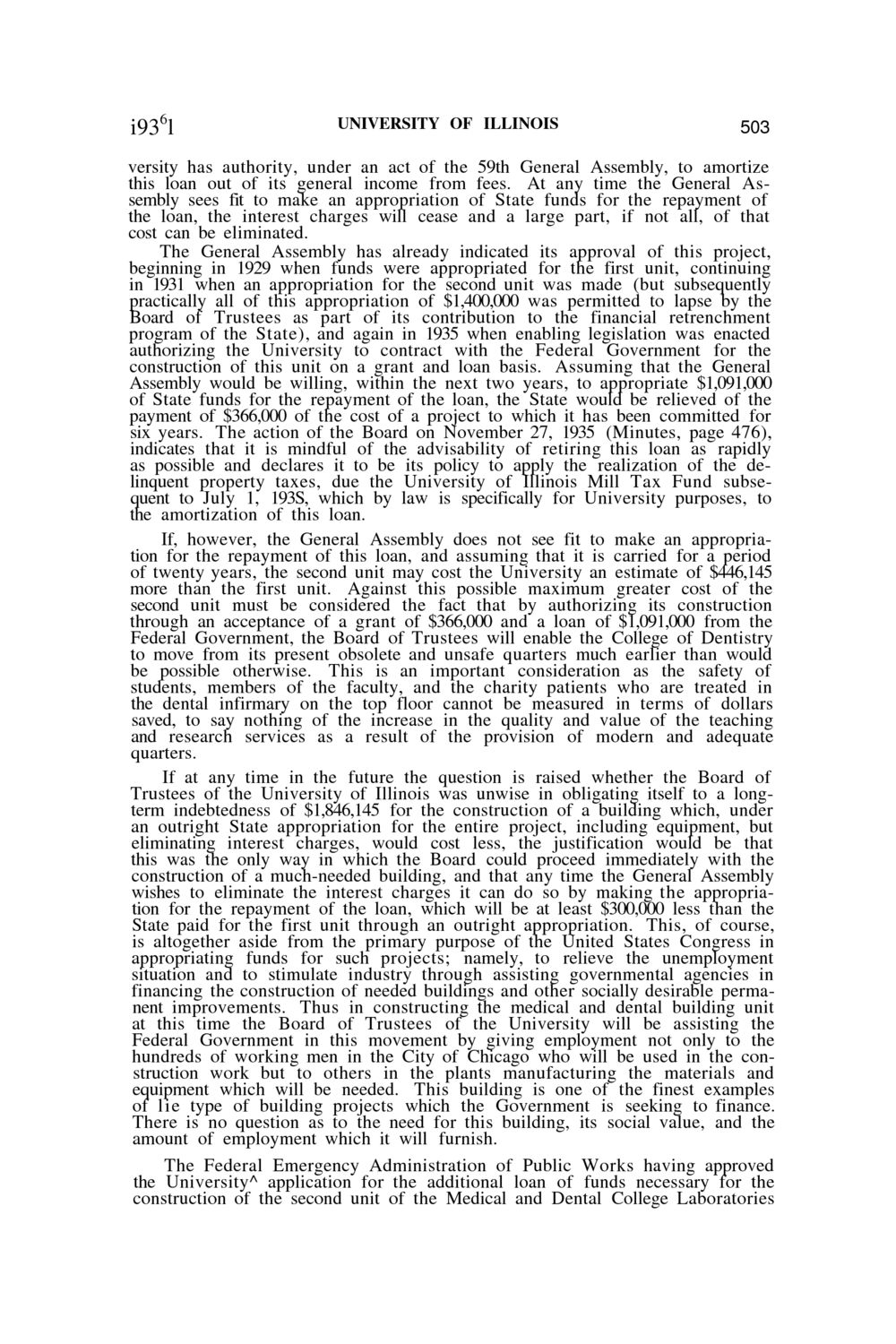| |
| |
Caption: Board of Trustees Minutes - 1936
This is a reduced-resolution page image for fast online browsing.

EXTRACTED TEXT FROM PAGE:
i936l UNIVERSITY OF ILLINOIS 503 versity has authority, under an act of the 59th General Assembly, to amortize this loan out of its general income from fees. At any time the General Assembly sees fit to make an appropriation of State funds for the repayment of the loan, the interest charges will cease and a large part, if not all, of that cost can be eliminated. The General Assembly has already indicated its approval of this project, beginning in 1929 when funds were appropriated for the first unit, continuing in 1931 when an appropriation for the second unit was made (but subsequently practically all of this appropriation of $1,400,000 was permitted to lapse by the Board of Trustees as part of its contribution to the financial retrenchment program of the State), and again in 1935 when enabling legislation was enacted authorizing the University to contract with the Federal Government for the construction of this unit on a grant and loan basis. Assuming that the General Assembly would be willing, within the next two years, to appropriate $1,091,000 of State funds for the repayment of the loan, the State would be relieved of the payment of $366,000 of the cost of a project to which it has been committed for six years. The action of the Board on November 27, 1935 (Minutes, page 476), indicates that it is mindful of the advisability of retiring this loan as rapidly as possible and declares it to be its policy to apply the realization of the delinquent property taxes, due the University of Illinois Mill Tax Fund subsequent to July 1, 193S, which by law is specifically for University purposes, to the amortization of this loan. If, however, the General Assembly does not see fit to make an appropriation for the repayment of this loan, and assuming that it is carried for a period of twenty years, the second unit may cost the University an estimate of $446,145 more than the first unit. Against this possible maximum greater cost of the second unit must be considered the fact that by authorizing its construction through an acceptance of a grant of $366,000 and a loan of $1,091,000 from the Federal Government, the Board of Trustees will enable the College of Dentistry to move from its present obsolete and unsafe quarters much earlier than would be possible otherwise. This is an important consideration as the safety of students, members of the faculty, and the charity patients who are treated in the dental infirmary on the top floor cannot be measured in terms of dollars saved, to say nothing of the increase in the quality and value of the teaching and research services as a result of the provision of modern and adequate quarters. If at any time in the future the question is raised whether the Board of Trustees of the University of Illinois was unwise in obligating itself to a longterm indebtedness of $1,846,145 for the construction of a building which, under an outright State appropriation for the entire project, including equipment, but eliminating interest charges, would cost less, the justification would be that this was the only way in which the Board could proceed immediately with the construction of a much-needed building, and that any time the General Assembly wishes to eliminate the interest charges it can do so by making the appropriation for the repayment of the loan, which will be at least $300,000 less than the State paid for the first unit through an outright appropriation. This, of course, is altogether aside from the primary purpose of the United States Congress in appropriating funds for such projects; namely, to relieve the unemployment situation and to stimulate industry through assisting governmental agencies in financing the construction of needed buildings and other socially desirable permanent improvements. Thus in constructing the medical and dental building unit at this time the Board of Trustees of the University will be assisting the Federal Government in this movement by giving employment not only to the hundreds of working men in the City of Chicago who will be used in the construction work but to others in the plants manufacturing the materials and equipment which will be needed. This building is one of the finest examples of lie type of building projects which the Government is seeking to finance. There is no question as to the need for this building, its social value, and the amount of employment which it will furnish. The Federal Emergency Administration of Public Works having approved the University^ application for the additional loan of funds necessary for the construction of the second unit of the Medical and Dental College Laboratories
| |